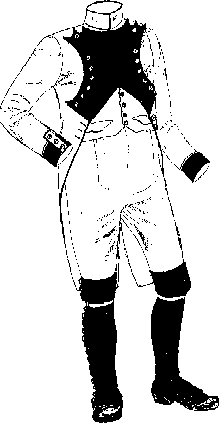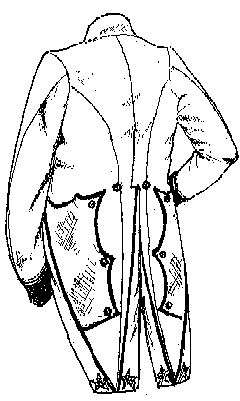ne of the effects of
the British naval blockade was that
it nearly changed the uniform of the
French infantry. Instead of the
familiar dark blue coats, soldiers of
the First Empire might have fought
Napoleon's battles dressed in white
like their Imperial Austrian
adversaries.
 In the 18th and 19th centuries, the
best blue dye came from a plant called
indigo, and it produced the rich dark blue
associated with French uniforms. Indigo,
however, is a semi-tropical plant grown in
Africa, India, and the West Indies, not in
France. The alternative, woad, makes a
less attractive greenish blue color, and
dyers had replaced woad with indigo in
the 17th Century. Some indigo was
getting through the British blockade, but
it was very expensive. Napoleon was
known as a thrifty ruler. Something more
affordable was needed.
In the 18th and 19th centuries, the
best blue dye came from a plant called
indigo, and it produced the rich dark blue
associated with French uniforms. Indigo,
however, is a semi-tropical plant grown in
Africa, India, and the West Indies, not in
France. The alternative, woad, makes a
less attractive greenish blue color, and
dyers had replaced woad with indigo in
the 17th Century. Some indigo was
getting through the British blockade, but
it was very expensive. Napoleon was
known as a thrifty ruler. Something more
affordable was needed.
By 1805, Napoleon was Emperor
and had built the "machine" to maintain
his power and future glory: the Grande
Armee. But in what kind of uniform
would the twenty divisions of highly
trained and disciplined infantry march off
to war? That same year a committee of
division chiefs of the Grande Armee
recommended to the Emperor that the
French infantry of the line should have
white uniforms. This decision had the
enthusiastic support of the Imperial
brother-in-law Marshal Murat, who was
famous for his elaborate and flamboyant
uniforms.
On 13 February, 1805 Napoleon ordered the issue of the new pattern uniform to the 3rd battalion of the 18th Regiment of the Line and the 3rd battalion of the 4th Legere (light infantry). The white-coated soldiers were an immediate success as they quickly became the
darlings of the Paris boulevards. Shortly thereafter, the War Ministry announced that the infantry would continue to wear blue only until 1808. By then all the soldiers should have received their white uniforms.
Following the 1805 campaign, a decree of 25 April, 1806 ordered twenty regiments to receive the white uniforms by 1807. Eventually, it was intended that all the infantry of the line would wear white uniforms. Except for the Dutch Grenadiers who kept their white and
crimson, only the Imperial Guard would retain dark blue coats under the new system.
An elaborate system of distinctive colors, their placement on lapels, collars,
cuffs, and turnbacks, plus the color of the buttons made it possible, in theory, to
identify a regiment at a glance. This system proved impractical in the field.
| Distinctive Colors on the French White Uniform |
|---|
Regiments in
Color Class | Distinctive
Color |
|---|
| 1 - 8 | Imperial Green |
| 9 - 16 | Black |
| 17 - 24 | Scarlet |
| 25 - 32 | Capucine
Bright Nasturtium Orange |
| 33 - 40 | Violet |
| 41 - 48 | Sky Blue |
| 49 - 56 | Rose Pink |
| 57 - 64 | Aurore
Gold Yellow |
| 65 - 72 | Dark Blue |
| 73 - 80 | Jonquille
Bright Yellow |
| 81 - 88 | Meadow Green |
| 89 - 96 | Rouge Garrance
Turkey or Madder Red |
| 97 - 104 | Crimson |
| 105 - 112 | Iron Gray |
Most of the regiments adhered to their distinctive color scheme, but commanders often changed the actual placement of the colors on the coats. Contemporary portraits exist of officers in the new white uniform when none was ever issued to their regiments. In the paintings of the Otto Manuscript which appear in Guy Dempsey's Napoleon's Soldiers [published by Arms & Armour Press in 1995, reviewed in Napoleon #1], there are illustrations of uniforms that clearly violate the regulations for the placement of distinctive colors.
| Arrangement of Colors on the White Coat (S=Solid, P=Piped) |
|---|
Regiments in
Color Class | Collar | Cuffs | Tail Pocket
Flap Position | Cuff Straps | Lapels | Button
Metal |
|---|
| First | S | S | Horizontal | P | S | Yellow |
| Second | P | S | Horizontal | P | S | Yellow |
| Third | S | P | Horizontal | P | S | Yellow |
| Fourth | S | S | Horizontal | P | P | Yellow |
| Fifth | S | S | Vertical | P | S | Yellow |
| Sixth | P | S | Vertical | P | S | Yellow |
| Seventh | S | P | Vertical | P | S | Yellow |
| Eighth | S | S | Vertical | P | P | Yellow |
Despite the implied urgency in the decrees, by 1807 France's supply system had been able to outfit only 11 of the 20 designated regiments with the white coats. The regiments that received them were the 3rd, 4th, 8th, 14th, 15th, 17th, 18th, 19th, 21st, 22nd, and 33rd. Due to
vagaries of distribution, two line infantry regiments not on the original list also received the new white uniforms, the 12th and the 53rd.
 Although it may appear otherwise, white uniforms were not difficult to
maintain under normal circumstances. The usual procedure was to let mud dry and
simply brush it out. As soldiers could cover stubborn stains with pipe-clay or
even white paint.
Although it may appear otherwise, white uniforms were not difficult to
maintain under normal circumstances. The usual procedure was to let mud dry and
simply brush it out. As soldiers could cover stubborn stains with pipe-clay or
even white paint.
The white uniform experiment, however, was doomed to failure. One
problem was a morale issue: some soldiers associated the white uniform with
France's ancien regime. After all the sacrifices of the Revolution, wearing
royalist white might be viewed as a betrayal. The prinnary problem however
was physical.
A white coat did not maintain a good appearance as well as darker colors on long campaigns. As a further disadvantage, it made even a minor wound appear fatal.
Hundreds of miles of marches through the summer, fall, and winter of 1807 had taken its toll. On the coats that survived, greens had faded to blues, reds to brown, and the more exotic colors to various shades of gray. White uniforms came out of the bogs of Poland jeered by
veterans that it was en pierrot-- a clown's costume.
At the peace conference in Tilsit which ended the campaign of 1807-08, Napoleon ordered a grand revue of his troops. Only the Imperial Guard looked like soldiers. The 12th and 21st regiments still had their (nominally) white uniforms. Evidently, they looked so disreputable
that it motivated the Emperor to decide that the infantry should keep its blue uniform.
Several units or parts of them, would continue to wear the white coats as late as 1811. When uniform supplies became desperate in 1814, white coats came out of storage for another brief appearance. But by 1808, the experiment had ended. The white uniform received an
epitaph when Napoleon said in a letter to the Minister of Administration of War: "the blue coat is a thousand times better."
Selected Bibliography:
Blond, Georges. La Grande Armee. Editions Robert Laffont, 1979. English version published by Arms and Armour Press, London, 1995.
Dempsey, Guy C. Napoleonic Soldiers: The Grande Armee as Depicted in the Paintings of the Otto Manuscript. London: Arms and Armour Press 1995. Highly recommended.
Elting, John R., Swords Around the Throne: Napoleon's Grande Armee. New York: The Free Press, 1988.
Lienhart, Dr., and Humbert, R. Les Uniformes de Armee Francaise. 5 volumes. Leipzig:
M. Ruhl, 1897.
"Les bleus sous l'habit blanc." Tradition No. 107, Feb. 1996.
About the author
Calvin W. (Cal) Hurd graduated from the US Naval Academy in 1951 and holds a Master's Degree in Electronics from the Air Force Institute of Technology. Hurd retired from the Air Force as a major in 1969. He has been studying military history since 1949 and collecting scale figures since 1951 whenhis wife Bea gave him a model soldier as a wedding present.
Back to Table of Contents -- Napoleon #4
© Copyright 1996 by Emperor's Press.
This article appears in MagWeb (Magazine Web) on the Internet World Wide Web.
The full text and graphics from other military history magazines and gaming magazines are available at http://www.magweb.com

 In the 18th and 19th centuries, the
best blue dye came from a plant called
indigo, and it produced the rich dark blue
associated with French uniforms. Indigo,
however, is a semi-tropical plant grown in
Africa, India, and the West Indies, not in
France. The alternative, woad, makes a
less attractive greenish blue color, and
dyers had replaced woad with indigo in
the 17th Century. Some indigo was
getting through the British blockade, but
it was very expensive. Napoleon was
known as a thrifty ruler. Something more
affordable was needed.
In the 18th and 19th centuries, the
best blue dye came from a plant called
indigo, and it produced the rich dark blue
associated with French uniforms. Indigo,
however, is a semi-tropical plant grown in
Africa, India, and the West Indies, not in
France. The alternative, woad, makes a
less attractive greenish blue color, and
dyers had replaced woad with indigo in
the 17th Century. Some indigo was
getting through the British blockade, but
it was very expensive. Napoleon was
known as a thrifty ruler. Something more
affordable was needed.
 Although it may appear otherwise, white uniforms were not difficult to
maintain under normal circumstances. The usual procedure was to let mud dry and
simply brush it out. As soldiers could cover stubborn stains with pipe-clay or
even white paint.
Although it may appear otherwise, white uniforms were not difficult to
maintain under normal circumstances. The usual procedure was to let mud dry and
simply brush it out. As soldiers could cover stubborn stains with pipe-clay or
even white paint.